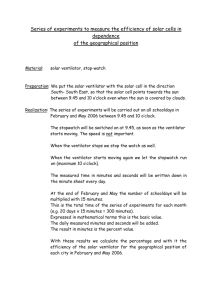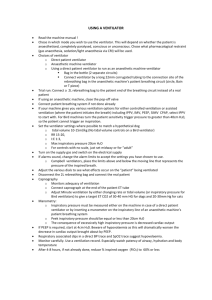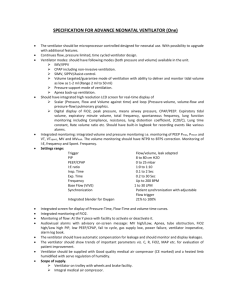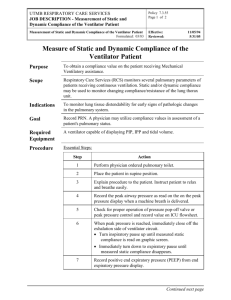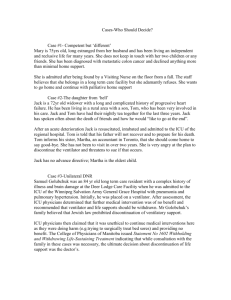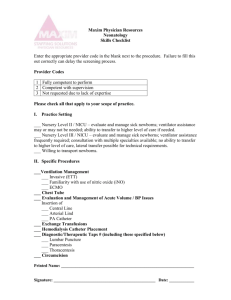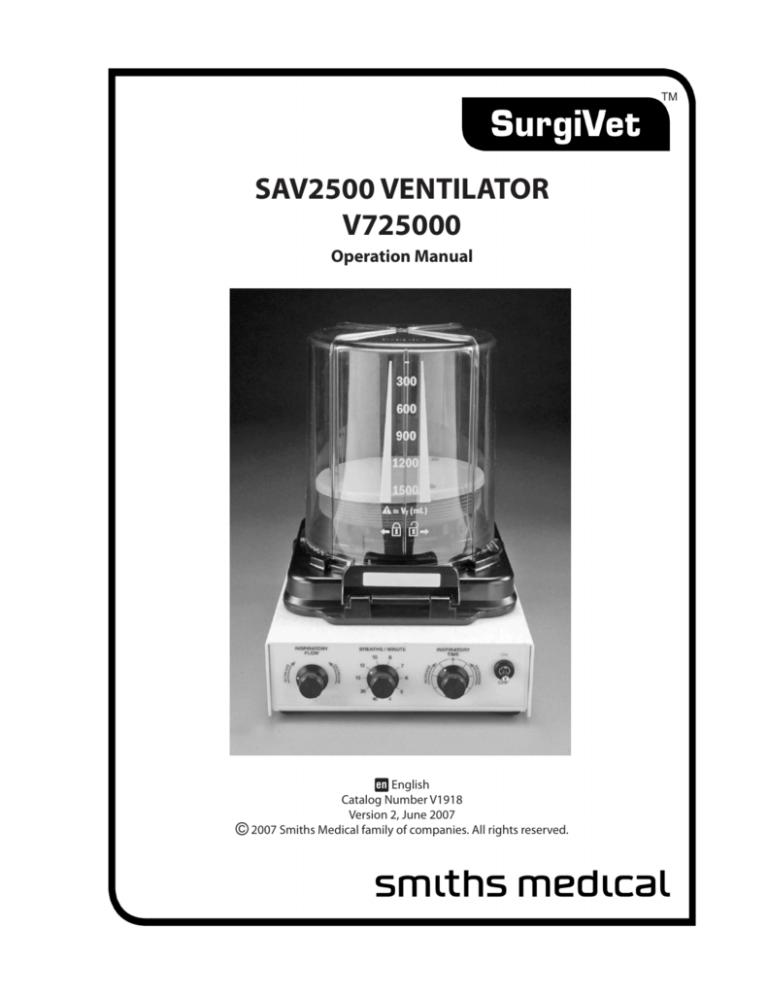
TM
SAV2500 VENTILATOR
V725000
Operation Manual
- English
Catalog Number V1918
Version 2, June 2007
© 2007 Smiths Medical family of companies. All rights reserved.
Table of Contents
Table of Contents
Warranty and Service Information......................................................................................... iii
Proprietary Notice....................................................................................................................................................................................iii
Warranty......................................................................................................................................................................................................iii
Limited Warranty..............................................................................................................................................................................iii
Disclaimer of Warranties................................................................................................................................................................iii
Conditions of Warranty..................................................................................................................................................................iii
Limitation of Remedies..................................................................................................................................................................iii
Warranty Procedure.................................................................................................................................................................................iv
Chapter 1: Introduction........................................................................................................ 1-1
Warnings, Cautions and Notes..........................................................................................................................................................1-1
Intended Use...........................................................................................................................................................................................1-1
Unpacking the Ventilator....................................................................................................................................................................1-2
Chapter 2: Getting Started................................................................................................... 2-1
Ventilating to Volume..........................................................................................................................................................................2-1
Ventilating to Pressure.........................................................................................................................................................................2-1
Ventilating to End Tidal CO2. ............................................................................................................................................................2-1
Becoming Familiar with the Ventilator Controls........................................................................................................................2-2
Front Panel......................................................................................................................................................................................2-2
Back Panel........................................................................................................................................................................................2-3
Chapter 3: Setting Up the Ventilator.................................................................................... 3-1
Testing the Ventilator...........................................................................................................................................................................3-2
Adjusting the Pressure Relief Valve (optional):...........................................................................................................................3-3
Chapter 4: Operating the Ventilator.................................................................................... 4-1
Chapter 5: Routine Maintenance and Troubleshooting..................................................... 5-1
Routine Maintenance...........................................................................................................................................................................5-1
Troubleshooting....................................................................................................................................................................................5-2
Chapter 6: Supplies and Accessories.................................................................................... 6-1
Ordering Information...........................................................................................................................................................................6-1
Appendix A: Bellows Assembly............................................................................................A-1
Exploded View of Bellows Assembly............................................................................................................................................. A-1
SurgiVet and the Smiths design mark are trademarks of the Smiths Medical family of companies. The symbol ®
indicates the trademark is registered in the U.S. Patent and Trademark Office and in certain other countries. All
other names and marks mentioned are the trade names, trademarks or service marks of their respective owners.
Clinician’s Operation Manual
Table of Contents
This page is intentionally left blank.
ii
Clinician’s Operation Manual
Warranty and Service Information
Warranty and Service Information
Proprietary Notice
Information contained in this document is copyrighted by Smiths Medical PM, Inc. and may not be duplicated in
full or part by any person without prior written approval of Smiths Medical PM, Inc. Its purpose is to provide the
user with adequately detailed documentation to efficiently install, operate, maintain and order spare parts for
the device supplied. All information contained in this document is believed to be current and accurate as of the
date of publication or revision, but does not constitute a warranty.
Warranty
Limited Warranty
Smiths Medical PM, Inc. (“Seller”) warrants to the original purchaser that the Product, not including applicable
accessories, shall be free from defects in material and workmanship under normal use, if used in accordance with
its labeling, for one year from the date of shipment to the original purchaser.
Disclaimer of Warranties
THE FOREGOING EXPRESS WARRANTY, AS CONDITIONED AND LIMITED, IS IN LIEU OF AND EXCLUDES ALL
OTHER WARRANTIES WHETHER EXPRESS OR IMPLIED, BY OPERATION OF LAW OR OTHERWISE, INCLUDING
BUT NOT LIMITED TO, ANY IMPLIED WARRANTIES OF MERCHANTABILITY OR FITNESS FOR A PARTICULAR
PURPOSE.
Seller disclaims responsibility for the suitability of the Product for any particular medical treatment or for any
medical complications resulting from the use of the Product. This disclaimer is dictated by the many elements
which are beyond Seller’s control, such as diagnosis or patient, conditions under which the Product may be used,
handling of the Product after it leaves Seller’s possession, execution of recommended instructions for use and
others.
Conditions of Warranty
This warranty is void if the Product has been altered, misused, damaged by neglect or accident, not properly
maintained, or repaired by persons not authorized by Seller. Misuse includes, but is not limited to, use not in
compliance with the labeling or use with accessories not manufactured by Seller. This warranty does not cover
normal wear and tear and maintenance items.
Limitation of Remedies
The original purchaser’s exclusive remedy shall be, at Seller’s sole option, the repair or replacement of the
Product. THIS IS THE EXCLUSIVE REMEDY. In no event will Seller’s liability arising out of any cause
whatsoever (whether such cause is based in contract, negligence, strict liability, tort or otherwise) exceed
the price of the Product, and in no event shall Seller be responsible for consequential, incidental, or
special damages of any kind or nature whatsoever, including but not limited to, lost business, revenues
and profits.
SAV2500 Ventilator Operation Manual
iii
Warranty and Service Information
Warranty Procedure
Should it be necessary to return the Product and/or accessories for evaluation or repair, please contact Clinical
Support at 1-888-745-6562 (262-513-8500 for International customers) to obtain a return authorization number.
Please provide the serial number of all equipment that will be returned. Any equipment returned for evaluation
or repair needs to be cleaned and decontaminated at your facility prior to being handled by our service
technicians. For cleaning instructions, please refer to the appropriate section in the operations manual.
If equipment is returned without being cleaned and decontaminated, and in our opinion it represents
a potential biological hazard, our service technicians reserve the right to withhold service until proper
cleaning and decontamination have been completed by the sender.
Reference the return authorization number when returning your Product, freight and insurance prepaid, to:
Smiths Medical PM, Inc.
Attn: Repairs/Return #
N7W22025 Johnson Drive
Waukesha, WI 53186-1856
Telephone: 262-513-8500
Toll Free: 1-800-745-6562 (U.S.A. only)
Fax: 262-513-9069
Seller will not be responsible for unauthorized returns or for loss or damage to the Product during the return
shipment. The repaired or replaced Product will be shipped, freight prepaid, to Purchaser.
To obtain warranty service outside the USA, contact your local distributor.
Keep all original packing material, including foam inserts. If you need to ship the device, use only the original
packaging material, including inserts. Box and inserts should be in original condition. If original shipping
material in good condition is not available, it should be purchased from Smiths Medical PM, Inc.
Damages occurred in transit in other than original shipping containers are the responsibility of the shipper. All
costs incurred returning devices for repair are the responsibility of the shipper.
iv
SAV2500 Ventilator Operation Manual
Chapter 1: Introduction
Chapter 1: Introduction
Intended Use
This ventilator is designed to be easy to use and extremely effective in the area of anesthesia ventilation. The
SAV2500 comes standard with a manual breath button, pneumatically controlled for electrical failures or
transport. Three simple control knobs set flow rate, breaths-per-minute and length of inspiratory cycle. The
ventilator can be made portable by adding an optional five base caster assembly or a universal ventilator
mounting assembly (see Chapter 6: Optional Supplies and Accessories).
Warnings, Cautions and Notes
6 Federal (U.S.A.) law restricts this device to sale by or on the order of a licensed veterinarian.
PLEASE READ AND UNDERSTAND THIS MANUAL BEFORE OPERATING THE ANESTHESIA VENTILATOR.
A TEST LUNG HAS BEEN PROVIDED TO ALLOW THE USER THE OPPORTUNITY TO BECOME FAMILIAR WITH
ALL CONTROLS AND FUNCTIONS OF THIS VENTILATOR.
WARNING! Incorrect use of this equipment can cause serious patient injury. It is the responsibility of the
user to understand all functions and the need to maintain this equipment to manufacturer’s
specifications and directions.
WARNING! DO NOT USE THIS UNIT IN THE PRESENCE OF FLAMMABLE ANESTHETICS.
WARNING! ELECTRIC SHOCK HAZARD IF VENTILATOR CASE IS REMOVED.
WARNING! Anesthesia machines used with ventilators must be checked regularly and be LEAK FREE.
A leaking machine can cause the ventilator not to perform to specifications and represents
possible patient injury.
WARNING! The ventilator is for VETERINARY USE ONLY.
CAUTION! Smiths Medical PM, Inc. shall not be responsible for any unauthorized repair or modifications
to the equipment or accessories or damages caused by unauthorized opening of the
ventilator.
NOTE! The ventilator is designed to be powered with medical grade oxygen.
SAV2500 Ventilator Operation Manual
1-1
Chapter 1: Introduction
Unpacking the Ventilator
Carefully remove the ventilator and accessories from the shipping carton. Save the packing materials in case the
monitor or accessories must be shipped or stored. Compare the accessories received with the list of accessories
below to make sure the shipment is complete.
Part Number
Description
32359B8
30.5 cm, 22 mm I.D. (12 inch, 0.87 in I.D.) Reusable Cuffed Hose
32359B7
122 cm, 22 mm I.D. (48 inch, 0.87 in I.D.) Reusable Cuffed Hose
32001B1
Adapter, 22 mm x 22 mm (0.87 in x 0.87 in)
32343B20
Silicone Adapter, 22 mm x 17 mm (0.87 in x 0.67 in)
32426B3
DISS Wye Connector (F x M x M Wye)
32391B1
Test Lung
32343B18
Adapter, 30 mm x 19 mm (1.18 in x 0.75 in)
32411B10
Power Pack with Cord
24 inch O2 Hose with DISS Female Connectors on Each End
32411B6
1500 ml Bellows Assembly
1-2
SAV2500 Ventilator Operation Manual
Chapter 2: Getting Started
Chapter 2: Getting Started
The SAV2500 Ventilator is very easy to operate and the unit should be run to become familiar with the controls
before the ventilator is connected to a patient. Before starting, decide whether to ventilate to pressure, end tidal
CO2, or volume. Most users ventilate to pressure or end tidal CO2 instead of volume.
Ventilating to Volume
If ventilating to volume, remember that a certain amount of volume is lost to circuit compliance. If the bellows
shows a volume of 400 ml being delivered, be aware that the delivered volume may be only 300 to 320 ml.
Ventilating to Pressure
If ventilating to pressure, most anesthesiologists recommend a pressure of 15 to 18 cm H2O as read from the
patient pressure manometer located on the anesthesia machine. When satisfied with the flow and an increase
patient pressure is desired, simply increase the Inspiratory Time. To decrease patient pressure, decrease the
Inspiratory Time. This is a unique feature of the SAV2500.
Ventilating to End Tidal CO2
If ventilating to ETCO2, most anesthesiologists recommend an ETCO2 of 35-45 mmHg. In order to achieve this,
the patient’s number of breaths per minute must be matched to the desired normal ETCO2 value by increasing or
decreasing the number of breaths per minute on the ventilator.
SAV2500 Ventilator Operation Manual
2-1
Chapter 2: Getting Started
Becoming Familiar with the Ventilator Controls
Front Panel
INSPIRATORY
FLOW
3
BREATHS / MINUTE
INSPIRATORY
TIME
8
10
1
6
INCREASE
15
CREASE
DE
CREASE
DE
INCREASE
12
OFF
5
20
SAV 2500 Anesthesia Ventilator
ON
*
4
40
4
2
Figure 2.1: Front Panel
1
On/Off Switch
Powers ventilator on or off.
2
Inspiratory Time
Increases or decreases the length of the inspiratory cycle and allows the varying ventilatory demands to be
met. Less Time = Less Volume
3
Inspiratory Flow
Controls the delivered volume to the patient.
4
Breaths/Minute
Increases or decreases the number of breaths per minute (4-40 BPM).
2-2
SAV2500 Ventilator Operation Manual
Chapter 2: Getting Started
Back Panel
11
10
1
7
8
9
2
5
3
4
6
Figure 2.2: Back Panel
1
Transport Breath (pneumatic manual)
Electricity is not needed for this function. This allows the ventilator to deliver a breath if electrical failure
occurs or if a manual breath is desired.
CAUTION: This will allow stacked breaths if used when electronic controls are active.
NOTE: The volume or pressure can be changed by adjusting the Inspiratory Time or the Inspiratory
Flow. Remember, the two are totally independent of one another. For example, if trying to
reach 20 breaths per minute, the Inspiratory Time must decrease in order to obtain those
breaths. If there is a long Inspiratory Time, there will not be enough time between the
cycles to achieve that rate. At 20 breaths per minute, there are only 3 seconds to get the
inspiratory/expiratory breath and refill the bellows for the next breath. Although it is rare
to use 20 breaths per minute, it is important to understand that it is necessary to use both
controls to achieve the desired number of breaths.
2
Exhaust
Drive gas escapes from here.
3
Power/A.C. Main
For transformer/power supply.
4
Fuse Housing
The fuse is located here (250 volt, ½ Amp).
5
Oxygen Inlet
Connect oxygen hose here.
6
Drive Gas Supply Port
The 32359B8 cuffed hose connects from here to the drive gas inlet. 8
SAV2500 Ventilator Operation Manual
2-3
Chapter 2: Getting Started
7
Pressure Relief Valve
This feature allows individual pressure limits to be set for each patient. When closed, it is pre-set at 60 cm
H2O (± 5 cm H2O). It may be opened if very delicate control of pressures is required, such as ventilating an
extremely small patient.
Note: Normal operational position for this valve is closed.
8
Drive Gas Inlet
The 32359B8 cuffed hose connects from here to drive gas supply port. 6
9
Gas Evacuation Port
Connect the purple 30 mm x 19 mm (1.18 inches x 0.75 in) adapter and waste gas evacuation hose here.
10
Supply Hose Inlet
Connect supply hose 11 for bellows to this inlet.
11
Bellows Supply Hose (part # 32359B7)
Connects the ventilator to the bag port on the anesthesia machine.
2-4
SAV2500 Ventilator Operation Manual
Chapter 3: Setting Up the Ventilator
Chapter 3: Setting Up the Ventilator
1. Pressure test the anesthesia machine to check for leaks. If leaks are present, this will not allow the ventilator
to function properly. If there are any questions about performing a pressure test, please contact Clinical
Support at (888)745-6562 or 262-513-8500.
2. Remove the breathing bag from the anesthesia machine bag port, attach a rebreathing circuit to the
inhalation/exhalation valves and close the pop-off valve/pressure relief on the anesthesia machine.
1
2
3
Figure 3.1: Setting Up the Ventilator
1
Supply Hose Inlet
2
Gas Evacuation Port
3
Drive Gas Inlet
3. Connect one end of the 122 cm (48 inch) cuffed hose to the bag port on the anesthesia machine and the
other end to the supply hose inlet on the left behind the bellows.
4. Connect one end of the 30.5 cm (12 inch) cuffed hose to the drive gas inlet on the right, behind the bellows,
and the other end to the port on the back of the ventilator labeled bellows.
5. Attach the 0.91 m (3 foot) green oxygen hose to the port labeled oxygen supply on the back of the
ventilator. When tightening the oxygen hose, it is best to use two wrenches. One wrench should be used
to hold the fitting at the back of the ventilator labeled oxygen supply in place. The other wrench should
be used to tighten the DISS Female fitting on the end of the oxygen hose. This will prevent inadvertent
loosening of the oxygen fitting at the back of the ventilator. Connect the other end of the hose to an oxygen
regulator set at 50-55PSI.
SAV2500 Ventilator Operation Manual
3-1
Chapter 3: Setting Up the Ventilator
If using the Oxygen Wye piece that was provided with the ventilator, configure the machine and ventilator as
shown in the following picture.
5
1
2
4
3
Figure 3.2: Oxygen Wye Connector
1
To Ventilator
2
To Oxygen Source
3
DISS Female Connector
4
Anesthesia Machine Oxygen Connection
5
Oxygen Wye Piece
6. Connect power cord and plug in to an outlet. There should be a green light on the converter of the power
cord.
7. Attach Test Lung to the end of the breathing circuit.
8. Attach 19 mm (0.75 in) waste gas evacuation hose to the purple adapter on the back of the bellows.
9. SLOWLY turn on oxygen supply. THE VENTILATOR IS NOW READY FOR TESTING.
Testing the Ventilator
When all hoses are attached, oxygen is on, and test lung connected, start becoming familiar with the ventilator
and simulate having a patient attached to the anesthesia machine.
1. Press the flush valve on the anesthesia machine to raise the bellows all the way to the top. Turn flowmeter
up to 1.5 to 2LPM. The bellows should stay at the top, but no pressure should build on the manometer.
2. Turn the Inspiratory Flow control knob counter clockwise to the OFF position. DO NOT OVER TIGHTEN.
3. Turn the Inspiratory Time control knob to 12:00 o’clock (center).
4. Set the Breaths Per Minute control knob at 10.
5. Turn the ON/OFF switch ON.
6. The ventilator will start cycling, but will not inflate the test lung. Slowly open the Inspiratory Flow control
knob ¼ turn at a time between each breath until the test lung starts to inflate, resembling an actual lung.
This flow should resemble a natural inhalation cycle from a healthy patient. The ventilator is now delivering
10 breaths per minute with an adequate flow.
3-2
SAV2500 Ventilator Operation Manual
Chapter 3: Setting Up the Ventilator
Adjusting the Pressure Relief Valve (optional):
1. Set ventilator controls as stated in the Test Procedure.
2. Turn the ventilator to the OFF position.
3. Keep the flowmeter at 1.5 to 2LPM.
4. Hold the Transport Breath button in and the bellows will descend, delivering 1500ml.
5. While holding the Transport Breath button in, turn the Pressure Relief Valve counterclockwise and watch the
bellows start to rise.
6. Watch the manometer. When the unit reaches the desired pressure, release the Transport Breath.
7. Now test to see that the valve will relieve where it was set. It may need a little more adjusting, but should
relieve at +/- 5cmH2O.
Pressure Relief Valve
Figure 3.3: Pressure Relief Valve
SAV2500 Ventilator Operation Manual
3-3
Chapter 3: Setting Up the Ventilator
This page is intentionally left blank.
3-4
SAV2500 Ventilator Operation Manual
Chapter 4: Operating the Ventilator
Chapter 4: Operating the Ventilator
CAUTION! Always make sure the anesthesia machine is pressure tested and leak free. A leaking machine
will alter the performance of the ventilator.
NOte! To become familiar with using the ventilator and to gain confidence in its operation, practice with
the ventilator using the test lung.
With the ventilator attached to the patient and the Inspiratory Time and Breaths/Minute at the desired position,
start turning the Inspiratory flow until the desired volume is reached. REMEMBER TO TURN THE INSPIRATORY
FLOW CONTROL SLOWLY WHILE BECOMING FAMILIAR WITH THE VENTILATOR. The breaths-per-minute can be
changed by simply turning the Breaths/Minute control. Either increase or decrease the number of breaths.
WARNING! If the flow rate is too high, or the inspiratory cycle is too long, this may create a high circuit
pressure. Watch the Patient Pressure Manometer on the anesthesia machine and be prepared
to adjust these controls accordingly so dangerous pressures will not be obtained.
WARNING! The mechanical breath should be as close to the patient’s natural breath as possible. This is
always the goal of ventilation.
When the ventilator is set and the settings are in the start-up positions, begin adjusting the Inspiratory Time
control to the left and then to the right. Notice how the length of the inspiratory cycle is increased or decreased.
WARNING! Always monitor the Patient Pressure Manometer on the anesthesia machine and be prepared
to adjust the settings on the ventilator controls.
SAV2500 Ventilator Operation Manual
4-1
Chapter 4: Operating the Ventilator
This page is intentionally left blank.
4-2
SAV2500 Ventilator Operation Manual
Chapter 5: Routine Maintenance and Troubleshooting
Chapter 5: Routine Maintenance and Troubleshooting
Routine Maintenance
The ventilator supply hose, bellows housing and bellows do come in contact with the breathing gases and
should be disassembled and cleaned on a regular basis. Use mild soapy water, rinse well, and dry completely
before reassembly.
DO NOT USE ALCOHOL.
DO NOT USE STEAM STERILIZATION.
DO NOT USE ETHYLENE OXIDE (ETO).
Bellows Diaphragm
The tear drop-shaped diaphragm located under the bellows should be checked on a routine basis to make sure it
seals properly (check for cracks, worn areas, etc).
NOTE: Be sure not to pinch the diaphragm when placing the rim on to the housing.
Bellows Flutter Valve
A 19mm round black rubber flutter valve on the bottom side of the bellows diaphragm should be inspected and
replaced if needed (check for tears, curling, worn areas, etc).
Bellows Ring Seal
The black rubber gasket around the bottom of the bellows assembly should be checked on a routine basis to
make sure it seals properly (check for cracks, worn areas, etc).
NOTE: All other components of the ventilator, such as the bellows and the amber bellows cover, should
be checked on a routine basis as well and replaced as needed.
SAV2500 Ventilator Operation Manual
5-1
Chapter 5: Routine Maintenance and Troubleshooting
Troubleshooting
For exploded view of the bellows, see Appendix A: Bellows Assembly.
Problem
The bellows will not stay at
the top of the canister; the
bellows will not fill.
Corrective Action
Pressure test the anesthesia machine to check for leaks
Leak test the bellows: remove the bellows, tip upside down, cover hole under
base with palm of hand to occlude, then turn bellows right side up (if there are
no leaks, the bellows should hold).
Check the diaphragm (32102B17), make sure it is in place, and be sure that the
flutter valve (32037B5) is present
Check the ring seal (3241117) around the bellows assembly
Check the oxygen source to the anesthesia machine and to the ventilator. Line
pressure should be at 50-55 psi.
Check the amber bellows cover (32411B19) to ensure it is locking in place
properly.
The ventilator will not cycle.
(If cycling, there will be a
clicking noise.)
No power
Check ON/OFF switch.
Check power supply; confirm there is a green light illuminated on the converter.
If there is no green light, check connection and try another working outlet. If
still no green light, a new power supply (32411B10) must be ordered.
If the ventilator is not working, but there is a green light on the power supply,
check the fuse (32205B5-250V, ½ AMP) on the back of the ventilator and
replace if necessary.
The bellows will not move
when the ventilator cycles.
Check the bellows assembly to ensure that all pieces are properly locked in
place.
If an oxygen leak can be detected around the ventilator head, there may be
tubing disconnected on the inside and the ventilator will need to be sent in for
service.
Please contact Clinical Support at 1-888-745-6562 (USA Only) or 262-513-8500 for questions and further
troubleshooting.
5-2
SAV2500 Ventilator Operation Manual
Chapter 6: Supplies and Accessories
Chapter 6: Supplies and Accessories
Cat. No
Description
Qty
V1918
Operation Manual
1 each
V7154
Roll Stand
1 each
V7260
Universal Mounting Bracket
1 each
V7310
300 ml Bellows
1 each
V7312
3L Bellows (Foal)
1 each
V725000
SAV2500 Ventilator
1 each
32001B1
Adapter, 22 mm x 22 mm (0.87 in x 0.87 in)
1 each
32343B18
Adapter, 30 mm x 19 mm (1.18 in x 0.75 in)
1 each
32343B20
Silicone Adapter, 22 mm x 17 mm (0.87 in x 0.67 in)
1 each
32359B7
122 cm, 22 mm I.D. (48 inch, 0.87 in I.D.) Reusable Cuffed Hose
1 each
32359B8
30.5 cm, 22 mm I.D. (12 inch, 0.87 in I.D.) Reusable Cuffed Hose
1 each
32391B1
Test Lung
1 each
32411B10
Power Pack with Cord
1 each
32426B3
DISS Wye Connector (F x M x M Wye)
1 each
Ordering Information
For ordering information, contact your local distributor or the Smiths Medical PM, Inc. Veterinary Division
Customer Service department.
Smiths Medical PM, Inc.
Veterinary Division
N7W22025 Johnson Drive
Waukesha, WI 53186-1856
SAV2500 Ventilator Operation Manual
Phone: (262) 513-8500
Toll-Free: (888) 745-6562 (U.S.A. only)
Fax: (262) 513-9069
Website: www.surgivet.com
6-1
Chapter 6: Supplies and Accessories
This page is intentionally left blank.
6-2
SAV2500 Ventilator Operation Manual
Appendix A: Bellows Assembly
Appendix A: Bellows Assembly
Exploded View of Bellows Assembly
32411B19
Cover SAV Bellows
32411B6
1500ml Bellows
32102B7
Base Bellows Rim
32102B17
Diaphragm and Seat
Assembly
32037B5
Valve Bellows Diaphragm
32411B18
Adapter Fixing
SAV Bellows
32411B17
Ring Seal Bellows
32102B16
Bellows Base
SAV2500 Ventilator Operation Manual
A-1
Appendix A: Bellows Assembly
This page is intentionally left blank.
A-2
SAV2500 Ventilator Operation Manual
Smiths Medical PM, Inc.
Veterinary Division
N7W22025 Johnson Drive
Waukesha, WI 53186-1856
Phone: (262) 513-8500
Toll-Free: (888) 745-6562 (U.S.A. only)
Fax: (262) 513-9069
Website: www.surgivet.com


